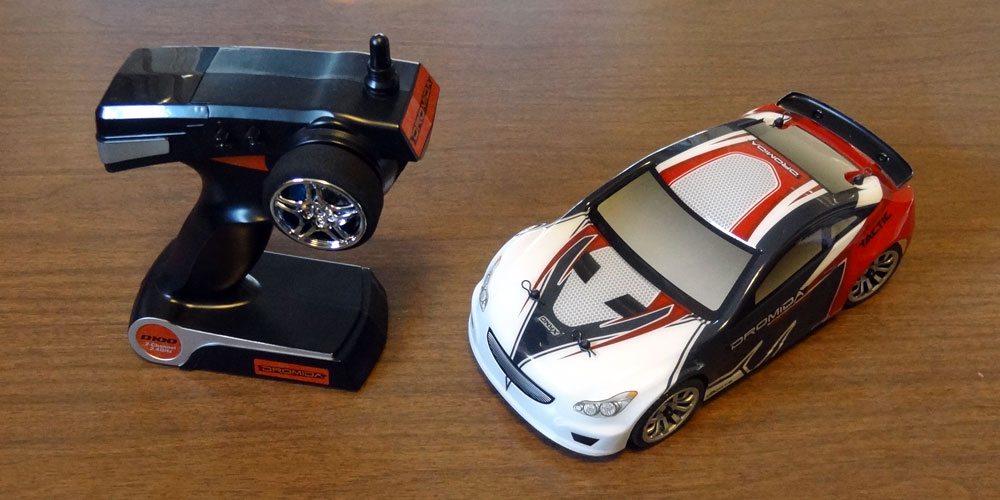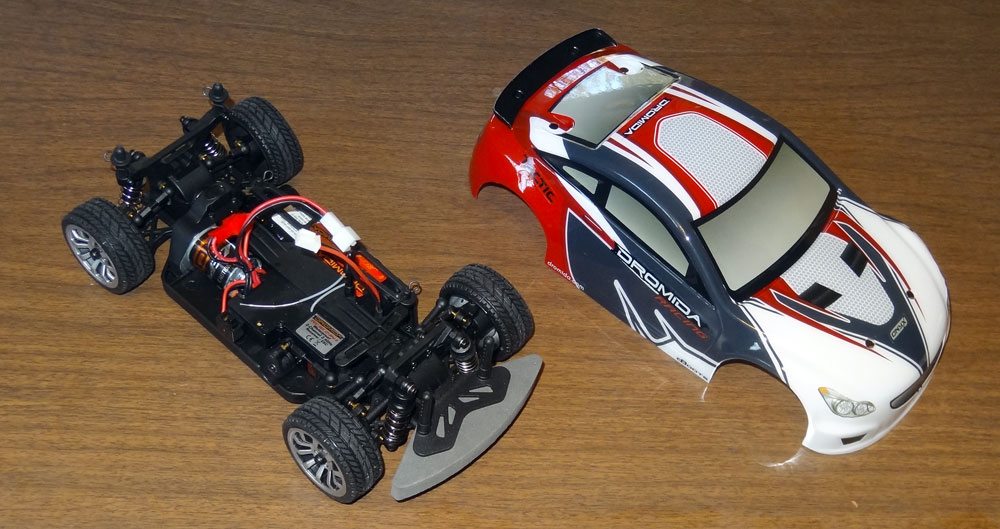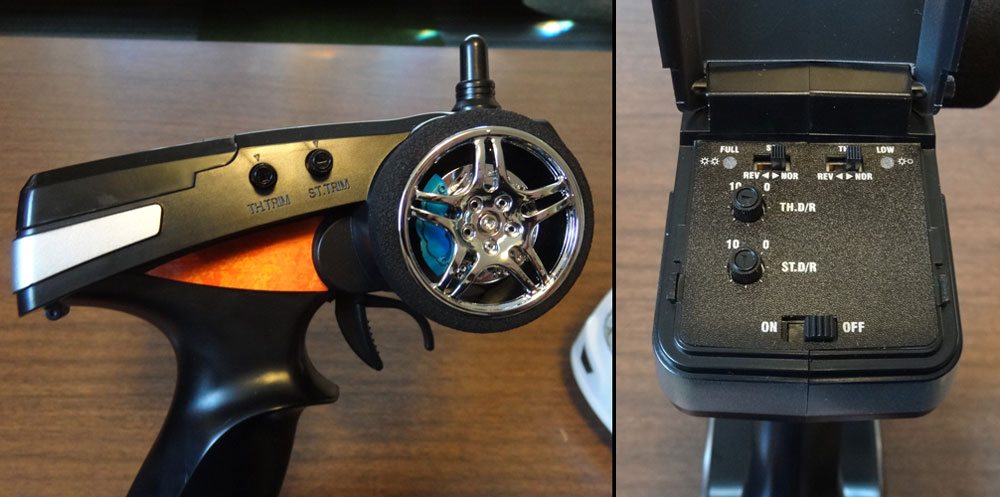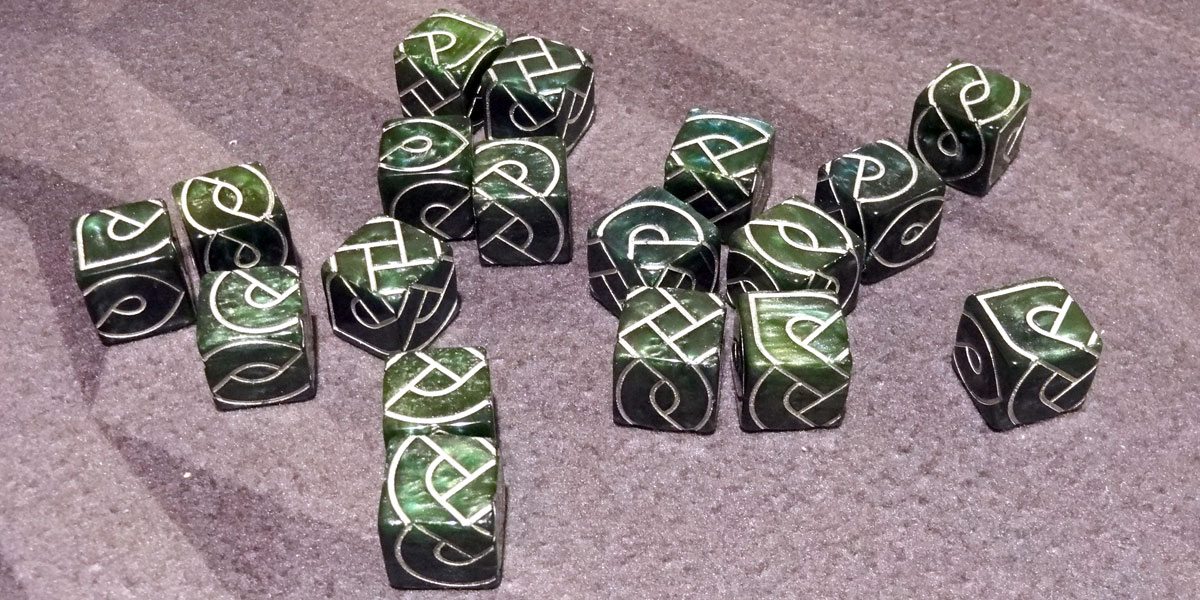
I’ve always enjoyed playing with R/C cars, but most of the ones I’ve played with have been targeted at kids—things like Jada’s “GirlMazing” line or some pocket-sized micro cars I found in Taiwan over a decade ago. Hobbico sent me their Dromida Touring Car to test, and it blew me away. So this is what an R/C car is supposed to be like.
First, the specs: the Dromida Touring Car retails for $109.99 and is available directly from the Dromida website, Amazon, and from some hobby shops. There is also a Rally Car version, as well as versions of both Touring and Rally with brushless motors for $149.99. It’s a 1/18 scale, about 11 inches long, and weighs 1.27 pounds. It’s a four-wheel-drive vehicle and comes fully assembled and ready to drive.

The body of the car is a very light shell—the colors and stripes are printed on, and the logos, headlights, and some other details are decals—everything is pre-applied right out of the box. The body attaches to the chassis with four clips.


The controller is a 2.4-GHz 2-channel radio, and operates as you’d expect: pull or push the trigger to go forward or back, and turn the wheel-shaped dial to steer. On the side of the remote there are two trim knobs so you can adjust the throttle and steering in case it’s drifting forward or pulling to one side. The back has a hinged door: underneath are the on/off switch for the remote, battery indicator lights, toggle switches to reverse the controls for the throttle and steering, and knobs for adjusting the throttle and steering rate. I found these particularly helpful when I first started, because the car is so fast that I was having trouble controlling it—I turned down both the throttle and the steering, and then gradually increased them after I got used to it. The remote uses 4 AA batteries, which are included.

There’s a 6-cell, 1300mAh NiMH battery that straps down to the chassis, and you just plug the two wires together and turn on the car’s switch when you’re ready to drive. The battery is charged with a USB charger (also included). I’ve gotten a good 30–45 minutes driving around on a charge, though I suppose that may vary a bit depending on driving conditions. Charging is supposed to take about 2.5 hours, though I did run into some issues initially where the battery charger was giving me error indicators. Hobbico sent me a replacement, which I was able to get working, but we never did figure out why the first charger didn’t work.
But on to the fun part, the driving! Here’s a brief demo—we took it over to the school blacktop on two different days and tried it out:
As you can see, the car is fast—I haven’t clocked it myself, but the box says 20 mph and I know at top speed we couldn’t catch it. (I edited out all the parts where we kept driving it into our feet because we were bad at steering and couldn’t get out of the way quickly enough.) The weight of the car is low to the ground and I was surprised to find out that I could pull off a J-turn pretty easily.
The shocks on the car let you handle bumps and cracks easily, and although it was hard to capture on video, you can see the car leaning slightly on turns, which looks pretty amazing. The steering is really responsive—a little too responsive at first, so I turned it down—so with some practice you can really zig and zag.
The front bumper is a big piece of hard foam, and we tested that (unintentionally) against all sorts of surfaces—people, posts, bikes, benches. The plastic of the shell got a bit scuffed up, but the bumper itself looks totally fine. It even survived a somewhat spectacular end-over-end crash when I hit the ramped edge of the playground rubber flooring.
Admittedly, I haven’t played around with serious R/C cars before, but I was pretty amazed by the speed and agility of the Dromida Touring Car. Most of the cars I’ve played with before are okay to drive around inside the house a little when you can’t get outdoors, but this thing is just way too fast to be indoors.
Thankfully, that leads me to another really nice feature, particularly for us here in Portland: it’s waterproof. It said so on the box, so we decided to put it to the test when it started drizzling one afternoon while we were out. I stayed under the pavilion and drove the car in and out of the rain, through puddles, and had no problems at all. I had to let it drip-dry later, because a lot of water splashed up under the body and onto the chassis, but it ran like a charm (and looked pretty cool kicking up a spray on the wet asphalt).
All in all, I found the Dromida Touring Car to be a thrilling drive—definitely one that’s made for big kids (like me), though it’s sturdy enough that I wasn’t afraid to let my daughters take it out for a spin, too. (Literally—that bit in the video where the car is just spinning around and around was my 10-year-old’s handiwork.) If you’re in the market for an R/C car, this one’s definitely worth a test drive.
Disclosure: Review unit provided by Hobbico.



